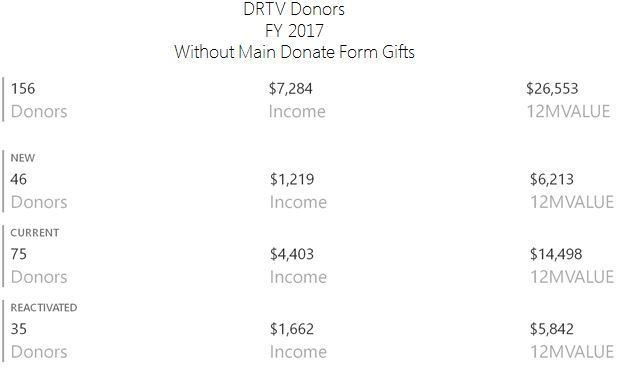WETA’s DRTV test campaign reveals exactly what DOESN’T work

WETA’s DRTV test campaign reveals exactly what DOESN’T work

In most cases, we use these blog posts to share successful projects or clear wins achieved by member stations. That’s not the case with a recent Direct Response Television (DRTV) test campaign at WETA in Washington, D.C. To offer the briefest summary possible, the pilot was a bust.

“We were proud of the work. It just didn’t do the trick,” reports John Begeny, WETA’s Executive Director of On-Air Fundraising. Nevertheless, he wanted to make the results of the campaign available to other stations. “We wanted to share these specific learnings because not only did it not work, but it wasn’t close to working.”
In January and February of 2017, WETA decided to experiment with Direct Response Television (DRTV), a format that has been very successful for non-profits outside the world of public television. Using emotionally compelling footage and appeals, DRTV asks viewers to respond directly to an organization by visiting a website or calling an 800 number. Organizations like World Vision, Save the Children, and the ASPCA—you’ve no doubt seen the sad or starving animals against the background of a Sarah McLachlan song—have used this format with great success.
WETA wondered if the approach might be a successful way to elicit donations from public television viewers. “We knew we didn’t have any of the things that are traditionally used for the emotional appeal,” says Begeny. What WETA did have was a captive audience of WETA fans. Other DRTV campaigns aired across channels and demographics. WETA’s appeals would be seen by people already watching the station. “We thought, ‘Let’s see if this will work.’”

But the spots just didn’t work.
For almost two months, they aired round-the-clock—outside of primetime—on TV26, WETA HD and WETA UK, with an additional two weeks of primetime airings on WETA UK. The goal for the pilot was a modest $109,000. The final result was a meager $27,000 in direct contributions to the campaign.
That was a huge disappointment for a campaign designed to bring in new or lapsed donors. “Ten out of every eleven viewers doesn’t make a donation but watches WETA,” says Begeny. “We thought we could reach more of that ten.” Instead, the Katie Couric spots were just as likely to catch the attention of the one in 11 who already contributed: Out of the donors who responded to the campaign, 50 percent were already active members.
“There are all these people who love us and want to donate to WETA but just don’t respond to pledge. We are reaching them through mail and other channels. We thought we could find more of them through TV spots that are non-premium-based and mission-focused,” Regen says. “Not only did it not work but it wasn’t even close to working.”
Even had all the responders been new, the amount generated by the campaign still would not have been worth the effort and expense.

Regen and Begeny chalk the test up to a learning experience and urge other stations to keep testing new approaches—even if many tests result in failure. “Every test that is a failure is a chance to learn,” Begeny says. “You learn from it and that helps you in your next venture. It gives you insight and that’s what is important.”
WETA vows to continue pursuing new ways to reach their audience—but they’ve taken DRTV off the table. “We believe deeply in testing and we would not discourage other stations from testing, but we wouldn’t go test anything too similar,” explains Regen, who says WETA continues to invest heavily in promoting Passport. “We suggest trying something substantially different from what we tried, instead of just tweaking the spots we did. We felt like it was far enough from working that other stations might be better off investing their time elsewhere instead of adjusting our DRTV approach.”
For additional details and reporting about WETA’s DRTV experiment, take a look at this presentation. To view all the campaign spots, click here
Questions about this blog post? Contact Tracy Ferrier, Director, Core Strategies, PBS Development Services
tbferrier@pbs.org | 703-739-5065
